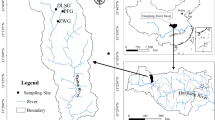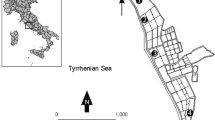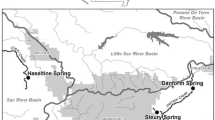Abstract
Epiphytic microbial biomass (as chlorophylla) was measured monthly in North Inlet Estuary, South Carolina, for 16 months on spatially distinct stem sections (bottom and middle) of dead and livingSpartina alterniflora growth forms (tall, medium, and short) exposed at low tide. The highest biomass was located on the bottom section of tall plants, presumably due to their relatively longer contact with creek water and associated phytoplankton, and their closer proximity to marsh sediments with associated benthic microalgae, both recruitment sources for epiphytes. Dead plants left standing from the previous year’s growth cycle had higher epiphytic biomass than living plants, which occurred mostly in late spring through fall. Epiphytic biomass was highest in the winter (mean of 1.77 mg chla (m2 marsh)−1) and lowest in the summer (mean of 0.34 mg chla (m2 marsh)−1). Because phytoplankton andSpartina production are lowest in the winter, the results emphasize the relative importance of epiphytes to growth of herbivores in this season.
Similar content being viewed by others
Literature Cited
Aksnes, D. L. andJ. K. Egge. 1991. A theoretical model for nutrient uptake in phytoplankton.Marine Ecology Progress Series 70:65–72.
Alexander, S. K. 1973. A seasonal study on the microbial flora ofSpartina alterniflora Loisel. Ph.D. Dissertation, Louisiana State University, Baton Rouge, Louisiana.
Angelidaki, K. J. andL. A. Leonard. 1996. Sediment and nutrient transport over individual tidal cycles in a tidal creek in North Carolina.Abstracts with Programs, Geological Society of America 28: 95.
Biggs, B. J. F., D. G. Goring, andV. I. Nikora. 1998. Subsidy and stress response of stream periphyton to gradients in water velocity as a function of community growth form.Journal of Phycology 34:598–607.
Blenkinsopp, S. A. andM. A. Lock. 1994. The impact of storm flow on river biofilm architecture.Journal of Phycology 30:807–818.
Boesch, D. F. 2000. Measuring the health of the Chesapeake Bay: Toward integration and prediction.Environmental Research 82: 134–142.
Bouseield, E. L. 1970. Adaptive radiation in sand burrowing amphipods.Chesapeake Science 2:143–154.
Burkholder, J. M., R. G. Wetzel, andK. L. Komparens, 1990. Direct comparison of phosphate uptake by adnate and loosely attached microalgae within an intact biofilm matrix.Applied and Environmental Microbiology 56:2882–2890.
Charles, F. andR. I. E. Newell. 1997. Digestive physiology of the ribbed musselGeukensia demissa (Dillwyn) held at different tidal heights.Journal of Experimental Marine Biology and Ecology 209: 201–213.
Cheng, S. S., W. C. Chen, andH. H. Hwang. 1997. Biofilm formation: The effects of hydrodynamic and substrate feeding patterns in three phase draft-tube fluidized bed for nitrification process.Water Science and Technology 36:83–90.
Childers, D. L., H. N. McKellar, R. F. Dame, F. H. Sklar, andE. R. Blood. 1993: A dynamic nutrient budget of subsystem interactions in a salt marsh estuary.Estuarine Coastal and Shelf Science 36:105–131.
Chrzanowski, T. H. andR. Zingmark. 1986. Passive filtering of microbial biomass bySpartina alterniflora.Estuarine Coastal and Shelf Science 22:545–557.
Currin, C. A., S. Y. Newell, andH. W. Paerl 1995. The role of standing deadSpartina alterniflora and benthic microalgae in salt marsh food webs: Considerations based on multiple stable isotope analysis.Marine Ecology Progress Series 121:99–116.
Currin, C. A. andH. W. Paerl. 1998a. Epiphytic nitrogen fixation associated with standing dead shoots of smooth cordgrass.Spartina alterniflora. Estuaries 21:108–117.
Currin, C. A. andH. W. Paerl. 1998b. Environmental and physiological controls on diel patterns of N2 fixation in epiphytic cyanobacterial communities.Microbiology and Ecology 35:34–45.
Dame, R., M. Alber, D. Allen, M. Mallin, C. Montague, A. Lewttus, A. Chalmers, R. Gardner, C. Gilman, B. Kjerfve, J. Pinckney, andN. Smith. 2000. Estuaries of the Atlantic coast of North America: Their geographical signatures.Estuaries 23:793–819.
Dame, R., D. Bushek, D. Allen, A. Lewitus, D. Edwards, E. Koepfler, andL. Gregory. 2002. Ecosystem response to bivalve density reduction: Management implications.Aquatic Ecology 36: 51–65.
Dame, R. andP. Kenny. 1986. Variability ofSpartina alterniflora primary production in the euhaline North Inlet estuary.Marine Ecology Progress Series 32:71–80.
Dame, R. F., J. D. Spurrier, andT. G. Wolaver. 1989. Carbon, nitrogen and phosphorus processing by an oyster reef.Marine Ecology Progress Series 54:249–256.
Day, Jr.,J. W., W. G. Smith, P. R. Wagner, andW. C. Stowe. 1973. Community structure and energy flow in a salt marsh shallow bay estuarine system in Louisiana. Office of Sea Grant Development, Center for Wetland Resources, Louisiana State University, Baton Rouge, Louisiana.
De Junge, V. N. andF. Colijn. 1994. Dynamics of microphytobenthos biomass in the Ems estuary.Marine Ecology Progress Series 104:185–106.
Duffy, J. E. andA. M. Harvilicz. 2001. Species-specific impacts of grazing amphipods in an eel grass bed community.Marine Ecology Progress Series 223:201–211.
Fallon, R. D., S. Y. Newell, andL. C. Groene. 1985. Phylloplane algae of standing deadSpartina alterniflora.Marine Biology 90: 121–127.
Fejes, E., D. Roelke, G. Gable, J. Heilman, K. Mcinnes, andD. Zuberer. 2005. Microalgal productivity, community composition, and pelagic food web dynamics in a subtropical, turbid salt marsh isolated from freshwater inflow.Estuaries 28:96–107.
Fleeger, J. W., K. R. Carman, S. Webb, N. Hilbun, andM. Pace. 1999. Consumption of microalgae by the grass shrimpPalaemonetes pugio Holthius.Journal of Crustacean Biology 19:324–329.
Froneman, P. W. 2001. Stable isotope (13C) composition of the food web in the temperate Kariega Estuary (Eastern Cape).African Journal of Aquatic Science 26:49–56.
Fulling, G. L. andM. S. Peterson. 1999. Estimation of small scale patchiness of zooplankton and an associated predator,Anchoa mitchilli.Gulf Research Reports 11:72.
Gleason, D. F. 1986. Utilization of salt marsh plants by post-larval brown shrimp: Carbon assimilation rates and food preferences.Marine Ecology Progress Series 31:151–158.
Goldman, J. C. andM. R. Dennet. 2001. Rapid nitrogen uptake by marine bacteria.Limnology and Oceanography 46:1195–1198.
Graf, G., W. Bengtsson, U. Diesner, R. Schultz, andH. Theede. 1982. Benthic response to sedimentation of a spring phytoplankton bloom: Process and budget.Marine Biology 67:201–208.
Grant, J. 1981. Animal-sediment-water column relations in intertidal sand-burrowing amphipods. Ph.D. Dissertation, University of South Carolina, Columbia, South Carolina.
Gregg, C. S. andJ. W. Fleeger. 1998. Grass shrimpPalaemonetes pugio predation on sediment and stem-dwelling meiofauna: Field and laboratory experiments.Marine Ecology Progress Series 175:77–86.
Haines, E. B. andC. L. Montague. 1979. Food sources of estuarine invertebrates analyzed using13C/12C ratios.Ecology 60:48–56.
Jackson, M. G. O. 2004. Ecology of the epiphytic microalgal community in North Inlet estuary, SC. Ph.D. Dissertation, University of South Carolina, Columbia, South Carolina.
Jacoby, J. M., M. R. Seeley, E. B. Welch, andR. R. Honer. 1990. Responses of periphyton to changes in current velocity, suspended sediment and phosphorus concentration.Freshwater Biology 42:215–232.
Jensen, L. M., K. Sand-Jensen, S. Marcher, andM. Hansen. 1990. Plankton community respiration along a nutrient gradient in a shallow Danish estuary.Marine Ecology Progress Series 61:75–85.
Jones, R. C. 1980. Productivity of algal epiphytes in a Georgia salt marsh: Effect of nundation frequency and implications for total marsh productivity.Estuaries 3:315–317.
Karp-Boss, L., E. Boss, andP. A. Jumars. 1996. Nutrient fluxes to planktonic osmotrophs in the presence of fluid motion.Oceanography and Marine Biology Annual Review 34:71–107.
Kemp, P. F., S. Y. Newell, andC. S. Hopkinson. 1990. Importance of grazing on the salt marsh grassSpartina alterniflora to nitrogen turnover in a macrofaunal consumer,Littoraria irrorata, and to decomposition of standing-deadSpartina.Marine Biology 104:311–319.
Kjerfve, B. 1978. Bathymetry as an indicator of net circulation in well-mixed estuaries.Limnology and Oceanography 23:816–821.
Kjerfve, B., L. B. Miranda, andE. Wolanski. 1991. Modeling water circulation in an estuary and intertidal salt marsh system.Netherlands Journal of Sea Research 28:141–147.
Kneib, R. T. andM. K. Knowlton. 1995. Stage-structure interactions between seasonal and permanent residents of an estuarine nekton community.Oecologia 103:425–434.
Kraeuter, J. N. andP. L. Wolf. 1974. The relationship of marine macroinvertebrates to salt marsh plants, p. 449–462.In R. H. Reimold and W. H. Queen (eds.), Ecology of Halophytes. Academic Press, New York.
Krager, C. D. 1992. The population demography of the salt marsh perwinkleLittoraria irrorata (Say). M.S. Thesis, University of South Carolina, Columbia, South Carolina.
Kreeger, D. A., C. J. Langdon, andR. I. E. Newell. 1988. Utilization of refractory cellulosic carbon derived fromSpartina alterniflora by the ribbed musselGeukensia demissa.Marine Ecology Progress Series 42:171–179.
Krest, J. M., W. S. Moore, L. R. Gardner, andJ. T. Morris. 2000. Marsh nutrient export supplied by groundwater discharge: Evidence from radium measurements.Global Biogeochemical Cycles 14:167–176.
Kulkarni, N. R., D. L. White, A. J. Lewitus, R. G. Tymowski, andD. C. Yoch. 2005. Dimethylsulfoniopropionate in a salt marsh estuary: Correlation to tidal cycle and phytoplankton assemblage composition.Marine Ecology Progress Series 289:13–25.
Langdon, C. J. andR. I. E. Newell. 1990. Utilization of detritus and bacteria as food sources by two bivalve suspension-feeders, the oysterCrassotrea virginica and the musselGeukensia demissa.Marine Ecology Progress Series 58:299–310.
Lewis, D. B. andL. A. Eby. 2002. Spatially heterogeneous refugia and predation risk in intertidal salt marshes.Oikos 96:119–129.
Lewitus, A. J., T. Kawaguchi, G. R. Ditulio, andJ. D. M. Keesee. 2004. Tron limitation of phytoplankton in an urbanized vs. forested southeastern U.S. salt marsh estuary.Journal of Experimental Marine Biology and Ecology 298:233–254.
Lewitus, A. J., E. T. Koepfler, andJ. T. Morris. 1998. Seasonal variation in the regulation of phytoplankton by nitrogen and grazing in a salt-marsh estuary.Limnology and Oceanography 43:636–646.
Lewitus, A.J., E. T. Koepfler, andR. J. Pigg. 2000. Use of dissolved organic nitrogen by a salt marsh phytoplankton bloom community.Archives of Hydrobiology Special Issues on Advances in Limnology 55:441–456.
Lewitus, A. J., D. L. White, R. G. Tymowski, M. E. Geesey, S. N. Hymel, andP. A. Noble. 2005. Adapting the CHEMTAX method for assessing phytoplankton taxonomic composition in southeastern U.S. estuaries.Estuaries 28:158–170.
Lewitus, A. J., B. M. Willis, K. C. Hayes, J. A. M. Burkholder, H. B. Glasgow, Jr.,P. M. Glibert, andM. K. Burke. 1999. Mixotrophy and nitrogen uptake byPfiesteria piscicida (Dinophyceae).Journal of Phycology 35:1430–1437.
Mackey, M. D., D. J. Mackey, H. W. Higgins, andS. W. Wright. 1996. CHEMTAX—a program for estimating class abundances from chemical markers: Application to HPLC measurements of phytoplankton.Marine Ecology Progress Series 144:265–283.
Marsh, A. G. andK. R. Tenore. 1990. The role of nutrition in regulating the population dynamics of opportunistic, surface deposit feeders in a mesohaline community.Limnology and Oceanography 35:710–724.
Moens, T., C. Luyten, J. J. Middelburg, P. M. J. Herman, andM. Vincx. 2002. Tracing organic matter sources of estuarine tidal flat nematodes with stable carbon isotopes.Marine Ecology Progress Series 234:127–137.
Monbet, Y. 1992. Control of phytoplankton biomass in estuaries: A comparative analysis of microtidal and macrotidal estuaries.Estuaries 15:563–571.
Morris, J. T., D. Porter, M. Neet, P. A. Noble, L. Schmidt, L. A. Lapine, andJ. Jensen. 2005. Integrating LIDAR elevation data, multispectral imagery, and neural network modeling for marsh characterization.International Journal of Remote Sensing 26:5221–5234.
Mukerji, D. andI. Morris. 1976. Photosynthetic carboxylating enzymes inPhaeodactylum tricornutum: Assay methods and properties.Marine Biology 36:199–206.
Newell, S. Y. andR. D. Fallon. 1989. Litterbags, leaf tags, and decay of nonabscised intertidal leaves.Canadian Journal of Botany 67:2324–2327.
Nixon, S. D. 1980. Between coastal marshes and coastal waters: A review of twenty years of speculation and research on the role of salt marshes in estuarine productivity and water chemistry, p. 437–525.In P. Hamilton and K. B. Macdonald (eds.), Workshop on Estuarine and Wetland Processes and Water Quality Modeling. New Orleans, Louisiana.
Ornes, W. H. andD. I. Kaplan. 1989. Macronutrient status of tall and short forms ofSpartina alterniflora in a South Carolina salt marsh.Marine Ecology Progress Series 55:63–72.
Page, H. M. 1997. Importance of vascular plant and algal production to macro-invertebrate consumers in a southern California salt marsh.Estuarine Coastal and Shelf Science 45:823–834.
Peters, F. andC. Marrase. 2000. Effects of turbulence on plankton: An overview of experimental evidence and some theoretical considerations.Marine Ecology Progress Series 205:291–306.
Piehler, M. F., J. G. Swistak, J. L. Pinckney, andH. W. Paerl. 1997. Sub-lethal effects of coastal petroleum pollution onSpartina alterniflora stem epiphytes.Chemosphere 35:2665–2674.
Pinckney, J. L. 1992. Ecology of benthic intertidal microalgal communities in North Inlet Estuary, South Carolina. Ph.D. Dissertation, University of South Carolina. Columbia, South Carolina.
Pinckney, J. L. andR. G. Zingmark. 1991. Effects of tidal stage and sun angles on intertidal benthic microalgal productivity.Marine Ecology Progress Series 76:81–89.
Pinckney, J. L. andR. G. Zingmark. 1993. Modeling the annual production of intertidal benthic microalgae in estuarine ecosystems.Journal of Phycology 29:396–407.
Quiño-Rivera, Z. J. andJ. W. Fleeger. 2005. The grazing effects of grass shrimp,Palaemonetes pugio, on epiphytic microalgae associated withSpartina alterniflora.Estuaries 28:274–285.
Roelke, D. L., L. A. Cifuentes, andP. M. Eldridge. 1997. Nutrient and phytoplankton dynamics in a sewage-impacted Gulf coast estuary: A field test of the PEG-model and equilibrium resource competition theory.Estuaries 20:725–742.
Rutledge, P. A. andJ. W. Fleeger. 1993. Abundance and seasonality of meiofauna, including harpacticoid copepod species, associated with stems of the salt-marsh cord grass,Spartina alterniflora.Estuaries 16:760–768.
Sellner, K., R. Zingmark, andT. Miller. 1976. Interpretations of the14C method of measuring the total annual production of phytoplankton in a South Carolina estuary.Botanica Marina 19: 119–125.
Silliman, B. R. andM. D. Bertness. 2002. A trophic cascade regulates salt marsh primary production.Proceedings of the National Academy of Sciences of the United States of America 99:10500–10505.
Singer, G. A., M. Panzenboeck, G. Weigelhofer, C. Marchesani, J. Waringer, W. Wanek, andT. J. Battin. 2005. Flow history explains temporal and spatial variation of carbon fractionation in stream periphyton.Limnology and Oceanography 50:706–712.
Stevenson, R. J. andR. Glover. 1993. Effects of algal density and current on ion transport through periphyton communities.Limnology and Oceanography 38:1276–1281.
Stowe, W. C. 1972. Community structure and production of the epiphytic algae in Barataria Bay area of Louisiana. Ph.D. Dissertation, Louisiana State University, Baton Rouge, Lousisiana.
Stowe, W. C. 1982. Diatoms epiphytic on the emergent grassSpartina alterniflora in a Louisiana salt marsh.Transactions of the American Microscopical Society 101:162–173.
Stowe, W. C. andJ. G. Gosselink. 1985. Metabolic activity of the epiphytic community associated withSpartina alterniflora.Gulf Research Reports 8:21–25.
Strickland, J. H. D. 1972. Research on the marine planktonic food web at the Institute of Marine Resources: A review of the past seven years of work.Oceanography and Marine Biology Annual Review 10:349–414.
Sullivan, M. J. 1982. Similarity of an epiphytic and edaphic diatom community associated withSpartina alterniflora.Transactions of the American Microscopy Scoiety 101:84–90.
Townsend, D. W. andL. M. Cammen. 1988. Potential importance of the timing of spring plankton blooms to benthic-pelagic coupling and recruitment of juvenile demersal fishes.Biological Oceanography 5:215–229.
Voulgaris, G. andS. T. Meyers. 2004. Net effect of rainfall activity on salt-marsh sediment distribution.Marine Geology 207:115–129.
White, D. L., D. E. Porter, andA. J. Lewitus. 2004. Spatial and temporal analyses of water quality and phytoplankton biomass in an urbanized versus a relatively pristine salt marsh estuary.Journal of Experimental Marine Biology and Ecology 298:255–273.
Whiting, G. J. andD. L. Childers. 1989. Subtidal advective water flux as a potentially important nutrient input to southeastern U.S.A. salt marsh estuaries.Estuarine Coastal and Shelf Science 28:417–431.
Wolaver, T. G., S. Hutchinson, andM. Marozas. 1986. Dissolved and particulate organic carbon in the North Inlet estuary: What controls their concentrations?Journal of Experimental Marine Biology and Ecology 9:31–38.
Wolaver, T. G., G. J. Whiting, R. F. Dame, T. M. Williams, andJ. D. Spurrier. 1988. Bly Creek ecosystem study—nitrogen exchange within a euhaline salt marsh basin of North Inlet. South Carolina.Marine Ecology Progress Series 49:107–116.
Yin, K., P. J. Harrison, andQ. Dortch. 1998. Effects of light on nutrient uptake.Journal of Experimental Marine Biology and Ecology 228:151–165.
Young, O. A. 1945. A limnological investigation of periphyton in Douglas Lake, Michigan.Transactions of the American Microscopy Society 64:1–20.
Zar, J. H. 1999. Biostatistical Analysis, 4th edition. Prentice Hall, Upper Saddle River, New Jersey.
Sources of Unpublished Materials
Kjerfve, B. personal communication. Dean, College of Geosciences, 3148 TAMU, Texas A&M University, College Station, Texas 77843-3148.
Spurrier, J. personal communication. Department of Statistics, University of South Carolina, Columbia, South Carolina 29208.
Author information
Authors and Affiliations
Corresponding author
Rights and permissions
About this article
Cite this article
Jackson, G., Zingmark, R., Lewitus, A.J. et al. Spatial and temporal dynamics of epiphytic microalgae on the cordgrassSpartina alterniflora in North Inlet Estuary, South Carolina. Estuaries and Coasts: J ERF 29, 1212–1221 (2006). https://doi.org/10.1007/BF02781821
Received:
Revised:
Accepted:
Issue Date:
DOI: https://doi.org/10.1007/BF02781821




